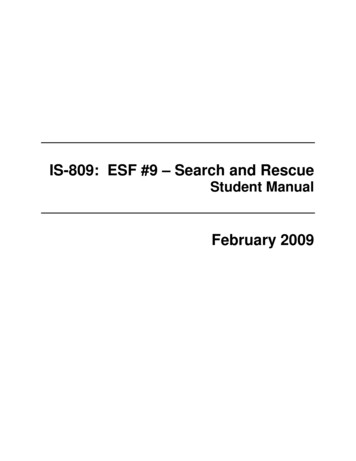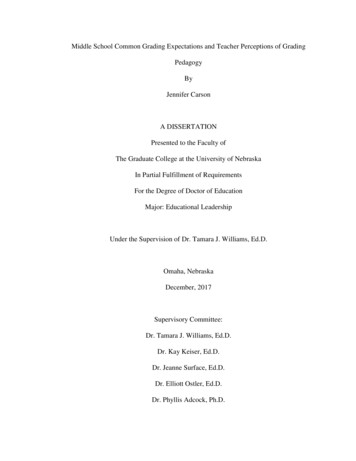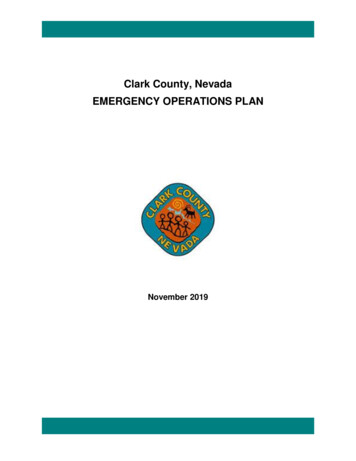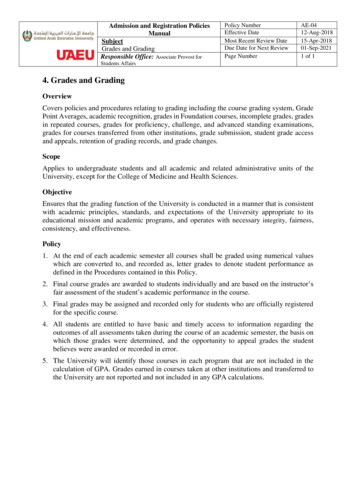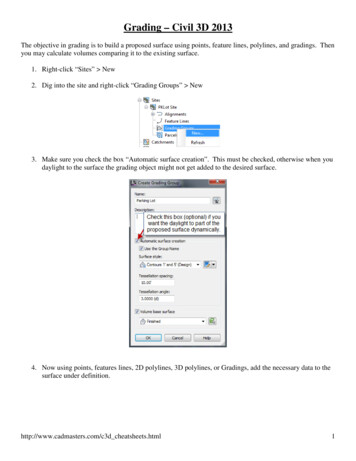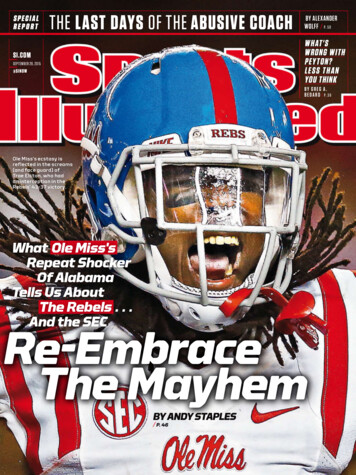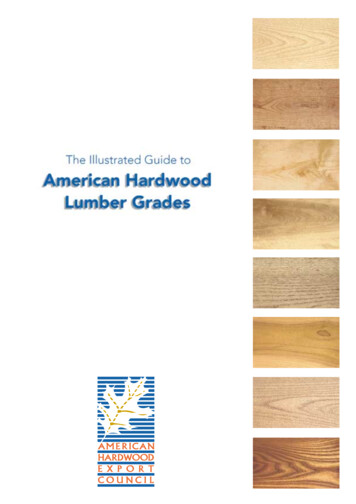
Transcription
ContentsIntroductionMeasurement12-3FAS and FAS/1F grades4No. 1C and No. 2AC grades5Characteristics and defects6-7Ash8Cherry9Cottonwood10Gum11Hard maple12Soft maple13Red oak14White oak15Tulipwood16Walnut17Additional guidance18 - 19Acknowledgments and contacts20Summary table21This publication is protected by copyright. The information contained in this publication, however, isdesigned for storage in retrieval systems and may be reproduced. All other aspects of the publication,including the photographs, may not be reproduced without AHEC's prior permission. AHEC takes noresponsibility for the information, which is offered as guidance only, and cannot be held responsible forany consequences.
IntroductionThe purpose of this publication is to providea simplified but thorough explanation of thegrading rules for American hardwood lumber.They were established over 100 years ago by thenewly formed National Hardwood LumberAssociation (NHLA). Today the NHLA has over2000 members worldwide, and the NHLA rules arestill the national standard for the US hardwoodindustry and form the basis for grading of exportlumber.Hardwood lumber is usually graded on the basis ofthe size and number of cuttings (pieces) that can beobtained from a board when it is cut up and used inthe manufacture of a hardwood product. The NHLArules were designed with the furniture trade in mindto provide a measurable percentage of clear,defect-free wood for each grade. The upper gradesprovide the user with long clear pieces, while theCommon grades are designed to be re-sawn intoshorter clear pieces.The upper grades, which will include FAS,FAS-One-Face (FAS/1F) and Selects, are most suitablefor long clear mouldings, joinery products such asdoor frames, architectural interiors; and furnitureapplications, which require a heavy percentage oflong wide cuttings.Wood is a natural material and by its very nature maycontain different characteristics and defects that needto be understood and allowed for in any givenapplication. The grading of sawn wood intocategories as it is processed helps to determine to alarge extent the value and potential use possible foreach board of sawn lumber.The Common grades, primarily Number 1 Common(No. 1C) and Number 2A Common (No. 2AC), arelikely to be most suitable for the kitchen cabinetindustry, most furniture parts, and plank and stripflooring. Worth noting is the fact that once re-sawn,the cuttings obtained from the Common grades willbe the same clear wood as the upper grades but insmaller (shorter and/or narrower) cuttings. The gradename simply designates the percentage of clear woodin the board, not the overall appearance.The NHLA grading rules provide both the buyer andseller with a consistent language to use in specifyinghardwood lumber transactions. Although the NHLAgrading rules are targeted for the US marketplace, areasonable knowledge is essential for buyersworldwide in order to attain their expected degree ofquality. The grade of lumber purchased by amanufacturer will determine both the cost and wastefactor that is achieved. Because the grades are basedon the percentage of clear wood in the board, manyof the beautiful, natural characteristics found inhardwoods are not considered in calculating the clearyield. This fact is highlighted by photographillustrations of the main grades, for 10 important UShardwood species, contained in this publication.The American hardwood temperate forest resource isthe largest of its kind anywhere in the world, with asignificant history of sustainability. Exploring theCommon grades, where possible, is invaluable inachieving the most value both in lumber cost andyield. These efforts will also help to ensure thesustainability of the resource for generations.1
MeasurementThe NHLA lumber grading rules adopted by the US hardwood industry are based on an imperialmeasurement system using inches and feet. In contrast most export markets are more familiar witha metric standard. Additionally, the grade rules were developed with random width and lengthlumber in mind. Any selection for particular specifications should be discussed prior to ordering.Board footA board foot (BF) is the unit of measurement for hardwood lumber.A board foot is 1 foot long x 1 foot wide x 1 inch thick. (1 foot 0.305 metres, 1 inch 25.4mm)The formula for determining board feet in a board is:(Width in inches x length in feet x thickness in inches) divided by 12The percentages of clear wood required for each grade are based on this 12' unit of measure.Surface measureSurface measure (SM) is the surface area of a board in square feet. To determine surface measure,multiply the width of the board in inches by the length of the board in feet and divide the sum by12 rounding up or down to the nearest whole number. The percentage of clear wood required foreach grade is based on the surface measure, not the board feet, and because of this all boards, nomatter what the thickness, are graded in the same way.Some examples for surface measure calculations are as follows:61 2" x 8' 12 41 3 4' SM8" x 12' 12 8' SM10" x 13' 12 1010 12 11' SM8'61 4"Example of SM and BF:The board above is a 2" thick, 61 4" wide, and 8' long.61 4" x 8' 12 41 4, thus the SM is 4'. Multiply the SM by the thickness 2" and the BF is 8'.When preparing a bundle tally for export, the boards are recorded by their width and length.Random widths above or below the half inch are rounded to the nearest whole inch. Board widthsfalling exactly on the half inch are alternatively rounded up or down. Lengths that fall betweenwhole foot increments are always rounded down to the nearest whole foot. For example a board51 4" width and 81 2' long is tallied 5" and 8'.2
Standard thickness for rough sawn lumberStandard thickness for rough sawn lumber is expressed in quarters of an inch. For example 1" 4 4.The majority of US hardwood lumber production is sawn between 1" and 2", although otherthicknesses are available in more limited volumes. The standard thicknesses and their exact metricequivalent are shown below.3/44/45/46/4(3 4" 19.0mm)(1" 25.4mm)(11 4" 31.8mm)(11 2" 38.1mm)8/410/412/416/4(2" 50.8mm)(21 2" 63.5mm)(3" 76.2mm)(4" 101.6mm)Standard thickness for surfaced (planed) lumberWhen rough sawn lumber is surfaced (planed) to a finished thickness, defects such as checks, stain,and warp are not considered when establishing the grade of a board, if they can be removed in thesurfacing (planing) process. The finished thickness for lumber of 11 2" and less can be determined bysubtracting 3 16" from the nominal thickness. For lumber 13 4" and thicker, subtract 1 4".Measurement of kiln dried lumberNet tally: The actual board feet of kiln dried lumber measured after kiln drying.Gross or green tally: The actual board feet measured before kiln drying. When kiln dried lumberis sold on this basis, the buyer can expect to receive approximately 7% less board feet because ofshrinkage in the kiln drying process.Estimating board feet in a bundle of lumberTo determine the board feet of one board, the procedure is to multiply the surface measure by thethickness. A bundle of lumber can be estimated in much the same manner. First, calculate thesurface measure of one layer of boards. Do this by multiplying the width of the bundle, minus gaps,by the length of the bundle and divide the sum by 12. If there are several lengths in the bundle,use an average length. Once one layer is estimated, multiply this sum by the total number oflayers.Example:Average width of unit 40"(lumber only, after allowing for gaps between boards)Length of unit 10'40" x 10' 400 12Thickness of lumber 8/4 33.33x2Number of layers 66.66x 10 666.67------------Estimated board feet of the bundle 667 BFConversion factors1":1m:1,000BF: (1MBF)1m3: 424 board feet (BF)1m3: 35.315 cubic feet (cu.ft)25.4 millimetres (mm)3.281 feet2.36 cubic metres (m3)3
FAS and FAS One Face (Selects)FASThe FAS grade, which derives from an original grade "First And Seconds", will provide the userwith long, clear cuttings - best suited for high quality furniture, interior joinery and solid woodmouldings. Minimum board size is 6" and wider and 8' and longer. The FAS grade includes a rangeof boards that yield from 831 3% (10 12ths) to 100% clear-wood cuttings over the entire surface of theboard. The clear cuttings must be a minimum size of 3" wide by 7' long or 4" wide by 5' long. Thenumber of these cuttings permitted depends on the size of the board with most boardspermitting one to two. The minimum width and length will vary, depending on species andwhether the board is green or kiln dried. Both faces of the board must meet the minimumrequirement for FAS.12'8"10'Note: Minimum yield 831 3% clear wood cuttings on the poor face of the board.12'8"5'5'FAS One Face (F1F)This grade is nearly always shipped with FAS. The better face must meet all FAS requirementswhile the poor face must meet all the requirements of the Number 1 Common grade, thusensuring the buyer with at least one FAS face. Often export shipments are assembled with an80-20 mix, 80% being the percentage of FAS boards and 20% being the percentage of F1F boards.These percentages are strictly left to individual buyer and seller agreement.SelectsThis grade is virtually the same as F1F except for the minimum board size required. Selects allowboards 4" and wider and 6' and longer in length. The Selects grade is generally associated withthe northern regions of the USA and is also shipped in combination with the FAS grade.Often export shipments of upper grades are simply referred to as FAS. The conventionalbusiness practice for American hardwoods is to ship these upper grades in some combination.Working closely with the supplier will enable the buyer to be sure that the expected quality will bereceived. Whether FAS is combined with F1F (Face And Better) or Selects (Sel And Better) everyboard in the shipment must have a minimum of one FAS face.Prime grade: This grade has evolved from the NHLA grade of FAS for the export market. It issquare edged and virtually wane free. The minimum clear yield will be select and better withappearance being a major factor. Minimum size of the boards varies, depending on the species,region, and supplier.Comsel grade: This grade has evolved from the NHLA grades of Number 1 Common and Selects.For the export market the minimum clear yield should be Number 1 Common or slightly betterwith appearance a main factor. Minimum size of the boards varies, depending on the species,region and supplier.Note: The terms Prime and Comsels are not standard NHLA definitions and therefore fall outsidethe official range of the NHLA grading rules.4
No. 1 Common and No. 2A CommonNumber 1 Common (No. 1C)The Number 1 Common grade is often referred to as the Cabinet grade in the USA because of itsadaptability to the standard sizes of kitchen cabinet doors used throughout the United States.Number 1 Common is widely used in the manufacture of furniture parts as well for this samereason. The Number 1 Common grades includes boards that are a minimum of 3" wide and 4' longand will yield clear face cuttings from 662 3% (8 12ths) up to, but not including, the minimumrequirement for FAS (831 3%). The smallest clear cuttings allowed are 3" by 3' and 4" by 2'.The number of these clear cuttings is determined by the size of the board. Both faces of theboard must meet the minimum requirement for Number 1 Common.12'8"6"4'6'Note: If the better face meets the requirements for FAS and the poor face meets the requirements forNumber 1 Common, the grade has the potential of being a F1F or Selects.12'8"4'4'Number 2A Common (No. 2AC)The Number 2A Common grade is often referred to as the Economy grade because of its priceand suitability for a wide range of furniture parts. It is also the grade of choice for the UShardwood flooring industry. The Number 2A Common grade includes boards that are a minimumof 3" wide and 4' long that yield from 50% (6 12ths) up to, but not including, theminimum requirement for Number 1 Common (662 3%). The smallest clear cutting allowed is 3" by2' and the number of these cuttings depends on the size of the board. If the poorest face meetsthe minimum requirements for Number 2A Common, it does not matter what the grade of thebetter face is.12'7'4"8"4"4"4'2'Note: If the better face meets the requirements for either FAS or Number 1 Common and the poor facegrades Number 2A Common, the grade of the board is Number 2A Common.12'8"4"3'2'4'There are lower NHLA grades than Number 2A Common but they are usually converted into dimensionparts, flooring parts, or used domestically in the USA.These Standard Grades form the framework by which all American hardwoods are traded. It isimportant to note that between buyer and seller any exception to these rules is permissible andeven encouraged. For a complete description of the NHLA grades, consult the NHLA's "Rules forthe Measurement and Inspection of Hardwoods and Cypress".5
Characteristics and defectsThe following pages show characteristics that occur in US hardwoods. Some are inherent tocertain species and others are generic to all. These characteristics either occur naturally in thelumber or as a result of the drying process. As has already been discussed, the grades are basedon the percentage of clear, defect free wood in the board.The NHLA grading rules allow the following characteristics in the clear cutting percentages forall grades and they are therefore not considered defects.HEARTWOOD and SAPWOOD:Heartwood is the mature wood, which isoften darker, extending from the sapwoodto the pith. Sapwood is the lighter colouredwood growing from inside the barkto the heartwood.BURL:A swirl or twist in the grain of the wood thatdoes not contain a knot.GUM STREAKS:Mineral-like streaks of colour naturallyoccurring only in cherry.MINERAL STREAKS:Streaks of colour ranging from olive toblackish-brown, which typically follow thegrain pattern.GLASSWORM:Random mineral like tracts.Usually associated with ashSTICKER MARK:The mark left on the board from aseasoning sticker, which can be removedin the surfacing planing process.Note: Although the NHLA grading rules do not consider these characteristics as defects for thestandard grades, allowances are made within the individual species. For example, species such ashard maple and ash are more desirable if there is a large portion of the board that is sapwood(white) and very little heartwood. The reverse is true when specifying species such as cherry, oakand walnut. It is essential that the buyers familiarise themselves not only with each species but thegrowing regions throughout the USA as well. Climate, soil and growing conditions such as hills andvalleys all play an important role in the growth of the tree. As previously stated, the NHLA rulesare the framework to begin the trading process. More information on characteristics found inindividual species is available in other AHEC technical publications.6
The NHLA grading rules do not allow the following characteristics in the clear cuttings for allgrades and they are therefore considered defects.BARK POCKET:A bark-filled distortion in the grain pattern.BIRD PECKS:Small blemishes in the grain patternresulting from birds pecking thatsometimes contain ingrown bark.An exception to the rule is hickory and elm.CHECK:A lengthwise opening on the face of theboard resulting from rapid or faulty drying.DECAY OR ROT:The breaking down of the wood substanceby fungi. The discoloration of the sapwoodindicates the initial evidence of decay.UNSOUND KNOT:A circular area that once formed the base ofa branch or twig and has a pith centre.(In some cases the wood may be missing).SOUND KNOT:A knot solid across its face, which shows noindication of decay.SPLIT:A lengthwise separation of the woodcreated as the wood dries. Shake isa separation between the annualgrowth rings.STICKER STAIN:Stain that is typically grey in colouroccurring from stickers used toseason lumber.WANE:Bark or the lack of wood caused by theround nature of the tree or log.WORM HOLES:Holes in the wood ranging in sizefrom 1 16" to over 1 4"PITH:The small soft core at the structural centreof the tree.GRUB HOLES:Holes larger than 1 4"7
Common name:American ashFraxinus sppOther names: Northern ash, Southern ashFASNo. 1CNo. 2AC8
Common name:American cherryPrunus serotinaOther names: American black cherryFASNo. 1CNo. 2AC9
Common name:American cottonwoodPopulus deltoidesOther names: Eastern cottonwood, Eastern poplar, Carolina poplarFASNo. 1CNo. 2AC10
Common name:American gumLiquidamber styracifluaOther names: Redgum, sapgum, sweetgumFASNo. 1CNo. 2AC11
Common name:American hard mapleAcer saccharum, A. nigrumOther names: Sugar maple, black mapleFASNo. 1CNo. 2AC12
Common name:American soft maplePrincipally Acer rubrum, A. saccharinumOther names: Red maple, silver mapleFASNo. 1CNo. 2AC13
Common name:American red oakQuercus sppOther names: Northern red oak, Southern red oakFASNo. 1CNo. 2AC14
Common name:American white oakQuercus sppOther names: Northern white oak, Southern white oakFASNo. 1CNo. 2AC15
Common name:American tulipwoodLiriodendron tulipiferaOther names: Yellow poplar (USA), tulip poplar (USA), canary whitewoodFASNo. 1CNo. 2AC16
Common name:American black walnutJuglans nigraOther names: Black walnut, American walnutFASNo. 1CNo. 2AC17
Additional guidanceRegional exceptions to the standard NHLA gradesThe NHLA grades cover the majority of commercial hardwood species growing in the USA.The following is a brief summary of various species and colour sorting that can be ordered fromthe American supplier.Red alderGrows exclusively in the Pacific Northwest between the vast stands of softwood timber such asDouglas fir and pine and is the most important commercial hardwood in this region. The gradingrules for red alder are geared more for specific end uses and appearance. The rules weredeveloped on the West Coast of the USA with those manufacturers and exports in mind.An exceptional cabinet wood typically sold surfaced (planed) and often cut to specific lengths andwidths. Consult with your local supplier for a more detailed explanation of the alder grades andproducts available.WalnutConsidered the elite of the American hardwoods, walnut is the favourite of the darker woods forfine furniture, interiors and gunstocks. Walnut grows in widely scattered stands throughout theeastern half of the United States, primarily in the Midwest. Historically, the grading rules for FASwalnut have been refined to encourage better use of this valuable species. Because of this, FASWalnut grades allow for smaller boards, both in width and length. Natural characteristics are alsoadmitted to a greater extent than the standard NHLA grade rules for other species. A detailedexplanation can be found in the NHLA rules book. Consult with your local supplier for the walnutgrades and products available.Colour sortingIn addition to sorting for grades or selecting specific widths, various species are commercially soldat an added value when colour is also considered. It is important to note, colour in thisexplanation refers to sapwood and heartwood.Number 1 and 2 whiteA colour selection typically made on hard maple, but can be applied to any species wheresapwood clear cuttings are desired, such as ash, birch, and soft maple.Number 1 white means both faces and edges of the clear cuttings must be all sapwood.Number 2 white means that one face and both edges of the clear cuttings must be sapwood andnot less than 50% sapwood on the reverse face.Sap and betterCommercially sold when only one face of the board needs to be sapwood. Usually applied to thesame species as Number 1 and 2 White, although just a little less stringent. In Sap and Better everyboard should have a minimum of one sapwood face in the clear cuttings.18
Red one face and betterCommercially sold when a minimum of one face of the board needs to be heartwood.Usually applied to species such as cherry, oak, walnut, gum, and even birch and maple in certainapplications. What the producer is looking for in this specification is that all clear cuttings musthave a minimum of one heartwood face.There is a wide range of additional options open to American hardwood producers in sorting andselecting specific lengths, widths and even grain patterns. If these can be agreedindividually between producers and buyers, there can be benefits by making modifications to thestandard grades shown in this guide. This may also assist with improving the yield from each logand thus contribute to the sustainability of the forest. It may also reduce costs to both sides or addvalue to the delivery.The steps in determining grade1.2.3.4.Determine species.Calculate the Surface Measure (SM).Determine the poor side of the board.From this poor face, calculate the percentage of clear wood available.Note: If Number 1 Common is the grade of the poor face, check the better face to see if it willgrade FAS for the F1F or Selects grades to be achieved.5. Once the grade is determined, check for any special features such as sapwood orheartwood cuttings for special colour sorts.6. Sort to bundles according to buyer and seller specifications.19
Contacts and acknowledgmentsAHEC contactsFor sources of supply of American hardwood products and information on AHEC activitiesworldwide, contact the following offices:AHEC - United States Headquarters1111 19th Street, NW, Suite 800Washington, D.C. 20036USATel: (1) 202 463 2720Fax: (1) 202 463 2787www.ahec.orgAHEC - Europe/Middle East/India3, St Michael's AlleyLondon EC3V 9DSUnited KingdomTel: (44) 20 7626 4111Fax: (44) 20 7626 4222www.ahec-europe.orgAHEC - KoreaUS Agricultural Trade Officec/o American Forest & Paper AssociationRoom #303, Leema Building146-1 Susong-dong, Chongro-kuSeoul (110-140)KoreaTel: (82) 2 722 3685/6Fax: (82) 2 720 1898AHEC - Southeast AsiaRoom 528, West WingNew World Office Building20 Salisbury RoadTsimshatsuiHong KongTel: (852) 2724 0228Fax: (852) 2366 8931www.ahec-seasia.orgAHEC - Japanc/o American Consulate General2-11-5 NishitenmaKita-ku, Osaka 530 - 0047JapanTel: (81) 6 6315 5101Fax: (81) 6 6315 5103www.ahec-japan.orgAHEC - MexicoUS Agricultural Trade OfficeJaime Balmes No. 8, Piso 2Col. Los Morales Polanco11510 Mexico, D.F.MexicoTel: (52) 55 5282 0909Fax: (52) 55 5282 0919www.ahec-mexico.orgAHEC - ChinaRoom 306, Building AFar East International Plaza99 Xianxia RoadShanghai 200051ChinaTel: (86) 21 6270 2222 ext 316Fax: (86) 21 6270 5555www.ahec-china.orgNHLA contactFor copies of the NHLA Grading Rules contact:National Hardwood Lumber AssociationBox 34518Memphis, TN 38184-0518USATel: (1) 901 377 1818Fax: (1) 901 382 6419www.natlhardwood.orgAcknowledgementsThe American Hardwood Export Council would like to thank the following for their cooperationand assistance in the production of this publication: National Hardwood Lumber Association,VKW Hardwoods, Anderson-Tully Lumber Company and Clarkswood Ltd.Thanks are also due to Bob Sabistina, former Chief Inspector at NHLA, for his guidanceand contribution.20
21Poor face of boardmust grade No 1 CommonSurface measure 13Surface measure x 8662 3%4" x 2'3" x 3'3" x 4'NO. 1 COMMONSurface measure2Surface measure x 650%3" x 2'3" x 4'NO. 2A & B COMMONThis chart summarises the main requirements for the standard grades. For complete information, consult the appropriate section ofthe NHLA Rule Book.Surface measure44" x 6'SELECTSBest face of boardmust grade FASSame as FASfor speciesbeing gradedFAS 1 FACE2the NHLA grades of FAS and No. 1 Common. It is necessary to consult with your supplier as to the exact specification beingapplied to these export grades.1 For kiln dried lumber, " shrinkage is permitted for the minimum size board in each grade. No. 2A Common requires clear cuttings. No. 2B Common is a utility grade requiring cuttings to be sound. When specified for export shipment, a comparison can be made respectively between export grades of PRIME and COMSEL withNotes: Formula toDetermine Numberof Clear CuttingsSurface measure x 10831 3%4" x 5'3" x 7'MinimumCutting SizeMinimumYield6" x 8'MinimumBoard sizeFASSummary of US hardwood lumber grades
Association (NHLA). Today the NHLA has over 2000 members worldwide, and the NHLA rules are still the national standard for the US hardwood industry and form the basis for grading of export lumber. Wood is a natural material and by its very nature may contain different characteristics and defects that need to be understood and allowed for in any .
